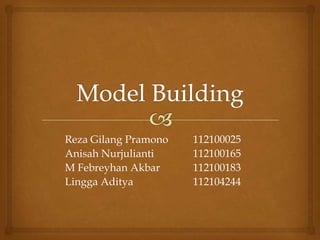Model building
•Download as PPTX, PDF•
0 likes•264 views
This document discusses converting a conceptual model into a simulation model. It covers structural elements like entities, locations, and resources that represent physical system components. Operational elements define how components interact through routings, arrivals, movement, scheduling, and downtime. Miscellaneous issues in modeling include rare occurrences, large-scale models, and cost modeling. The goal is to simplify reality while representing how a system operates based on data gathered in the conceptual model.
Report
Share
Report
Share

Recommended
Recommended
More Related Content
Similar to Model building
Similar to Model building (20)
Introduction to Object orientation , Modeling as a Design Technique Modeling ...

Introduction to Object orientation , Modeling as a Design Technique Modeling ...
Goal Dynamics_From System Dynamics to Implementation

Goal Dynamics_From System Dynamics to Implementation
Model building
- 1. Reza Gilang Pramono 112100025 Anisah Nurjulianti 112100165 M Febreyhan Akbar 112100183 Lingga Aditya 112104244
- 2. Introduction Converting a Conceptual Model to a Simulation Model Structural Elements Operational Elements Miscellaneous Modelling Issues Mind Map
- 3. Modelling is more than knowing how to use a simulation software tool. Modelling is considered an art or craft as much as a science Introduction
- 4. The Conceptual Model is the result of the data- gathering effort and is a formulation in one’s mind of how a particular sistem operates Building a simulation model requires that this conceptual be converted to a simulation model Converting a Conceptual Model to a Simulation Model
- 5. Modelling Paradigms A Modelling Paradigm determines the particular “World View” that one should have when modelling a system Model Definition A Model is a simplified representation of reality with emphasis on the word simplified Converting a Conceptual Model to a Simulation Model
- 6. Model objects represents the structural elements in a system such as machines, people, work areas. Simple object classification in ProModel: Entities Locations Resource Paths Structural Elements
- 7. Define the behaviour of the different physical elements in the system and how they interact Routings Entity Operations Entity Arrivals Entity and Resources Movement Accessing Locations and Resources Resource Scheduling Downtime and Repairs Operational Elements
- 8. Modelling Rare Occurrences Large-Scale Modelling Cost Modelling Miscellaneous Modelling Issues
